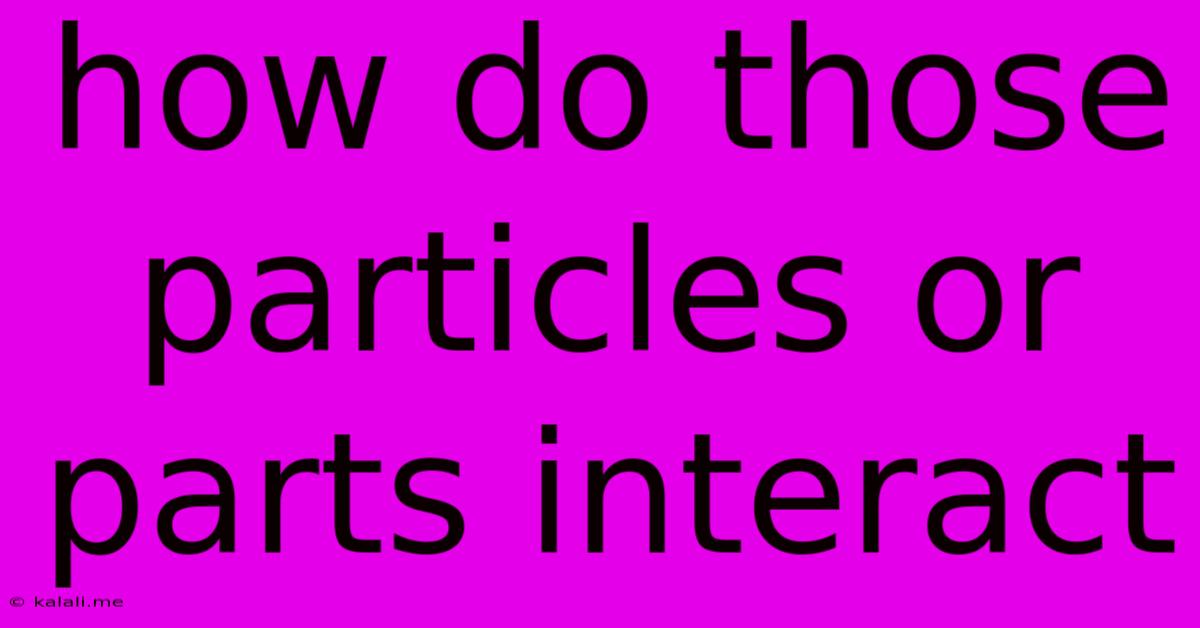How Do Those Particles Or Parts Interact
Kalali
May 23, 2025 · 4 min read

Table of Contents
How Do Particles Interact? A Deep Dive into the Fundamental Forces
Understanding how particles interact is fundamental to comprehending the universe. From the smallest subatomic particles to the largest celestial bodies, interactions govern everything we see and experience. This article delves into the four fundamental forces that dictate these interactions, exploring their mechanisms and the implications for our understanding of physics.
This article will cover the strong nuclear force, weak nuclear force, electromagnetic force, and gravitational force, explaining how these forces govern particle interactions at different scales. We will explore the Standard Model of particle physics and its role in explaining these fundamental interactions. Finally, we will touch upon open questions and ongoing research in particle physics, highlighting the ongoing quest to unify our understanding of these forces.
The Four Fundamental Forces: Shaping the Universe
The universe is governed by four fundamental forces, each with its unique characteristics and range of influence:
-
Strong Nuclear Force: This force is responsible for binding protons and neutrons together within the atomic nucleus. It's the strongest of the four forces but acts only over extremely short distances – approximately the size of an atomic nucleus. Its strength is crucial for the stability of matter, as it overcomes the electromagnetic repulsion between positively charged protons. Understanding the strong force is key to understanding nuclear reactions, including nuclear fusion in stars and nuclear fission in nuclear power plants. Quarks, the fundamental constituents of protons and neutrons, interact through the strong force via the exchange of gluons.
-
Weak Nuclear Force: Responsible for radioactive decay, the weak force is significantly weaker than the strong force and also acts over very short distances. It plays a crucial role in processes like beta decay, where a neutron transforms into a proton, an electron, and an antineutrino. The weak force is mediated by the exchange of W and Z bosons. It’s vital for understanding stellar nucleosynthesis and the evolution of stars.
-
Electromagnetic Force: This is the force responsible for interactions between electrically charged particles. It's significantly weaker than the strong force but has a much longer range, extending theoretically to infinity. Electromagnetism governs the interactions of electrons with protons in atoms, forming molecules and driving chemical reactions. It's mediated by the exchange of photons. Light, radio waves, and other forms of electromagnetic radiation are all manifestations of this force. Understanding electromagnetism is crucial to comprehending chemistry, materials science, and countless technological applications.
-
Gravitational Force: This is the weakest of the four fundamental forces but has an infinite range. Gravity acts on all matter and energy, attracting objects with mass towards each other. It's responsible for the structure of the universe, holding planets in orbit around stars, stars in galaxies, and galaxies in clusters. The mechanism behind gravity is still an area of active research, with Einstein's theory of General Relativity providing the best current description. While we understand its effects well, a complete quantum description of gravity remains elusive.
The Standard Model and Beyond
The Standard Model of particle physics is a theoretical framework that successfully describes the interactions of three of the four fundamental forces: the strong, weak, and electromagnetic forces. It postulates the existence of fundamental particles, including quarks and leptons, and force-carrying bosons. However, gravity remains outside the framework of the Standard Model. Scientists are actively searching for a unified theory that can explain all four forces, a "Theory of Everything," which remains one of the biggest challenges in modern physics. This involves exploring concepts like string theory and loop quantum gravity.
Open Questions and Ongoing Research
Despite significant advancements, many questions remain unanswered in particle physics. The search for dark matter and dark energy, which constitute the vast majority of the universe's mass-energy, is a major focus. Understanding the asymmetry between matter and antimatter in the universe is another crucial area of research. The pursuit of a unified theory of all fundamental forces continues to drive experimental and theoretical efforts worldwide. The Large Hadron Collider (LHC) and other particle accelerators are instrumental in pushing the boundaries of our understanding of particle interactions.
In conclusion, the interactions of particles are governed by four fundamental forces, each with unique characteristics and ranges. The Standard Model provides a robust framework for understanding these interactions, but significant challenges and open questions remain. Continued research is crucial to unravel the mysteries of the universe and achieve a more complete understanding of how particles interact at all scales.
Latest Posts
Latest Posts
-
Does A Simile Use Like Or As
May 23, 2025
-
Is The Last Author On The Paper The Most Important
May 23, 2025
-
How Long Can You Store Gas In A Can
May 23, 2025
-
Grab An Image Thats Outside Display
May 23, 2025
-
Blender Weird Face Showing Up When Not In Edit Mode
May 23, 2025
Related Post
Thank you for visiting our website which covers about How Do Those Particles Or Parts Interact . We hope the information provided has been useful to you. Feel free to contact us if you have any questions or need further assistance. See you next time and don't miss to bookmark.